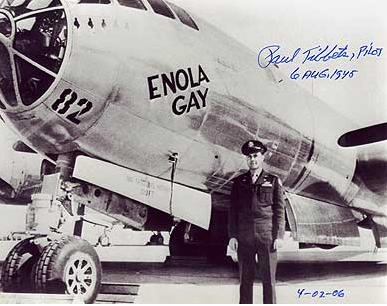
What more can you say.
Brig. Gen. Paul W. Tibbets Jr., the commander and pilot of the Enola Gay, the B-29 Superfortress that dropped the atomic bomb on Hiroshima in the final days of World War II, died today at his home in Columbus, Ohio. He was 92.Sad, that last part is. That is where DailyKOS, MoveOn.org, ANSWER, and CodePink have brought us. Enough of that, what a record of service.
His death was announced by a friend, Gerry Newhouse, who said General Tibbets had been in decline with a variety of ailments. Mr. Newhouse said General Tibbets had requested that there be no funeral or headstone, fearing it would give his detractors a place to protest.
...
After attending the University of Florida and University of Cincinnati, he joined the Army Air Corps in 1937.A great officer, pilot, and American. Fair winds and following seas.
On Aug. 17, 1942, he led a dozen B-17 Flying Fortresses on the first daylight raid by an American squadron on German-occupied Europe, bombing railroad marshaling yards in the French city of Rouen. He flew Gen. Dwight D. Eisenhower to Gibraltar in November 1942 en route to the launching of Operation Torch, the invasion of North Africa, and participated in the first bombing missions of that campaign.
After returning to the United States to test the newly developed B-29, the first intercontinental bomber, he was told in September 1944 of the most closely held secret of the war: scientists were working to harness the power of atomic energy to create a bomb of such destruction that it could end the war.
He was ordered to find the best pilots, navigators, bombardiers and supporting crewmen and mold them into a unit that would deliver that bomb from a B-29.
In his memoir “Now It Can Be Told,” Lt. Gen. Leslie R. Groves Jr., who oversaw the Manhattan Project, said that Colonel Tibbets had been selected to train the crews because “he was a superb pilot of heavy planes, with years of military flying experience, and was probably as familiar with the B-29 as anyone in the service.”
He took command of the newly created 509th Composite Group, a unit of 1,800 men who trained amid extraordinary security at Wendover Field in Utah.
In the summer of 1945, Colonel Tibbets oversaw his unit’s transfer for additional training on Tinian in the Northern Marianas. On July 16, an atomic bomb was successfully tested in the New Mexico desert, and when Japan ignored a surrender demand issued at the Potsdam Conference, Colonel Tibbets completed final preparations to drop a uranium bomb.









No comments:
Post a Comment